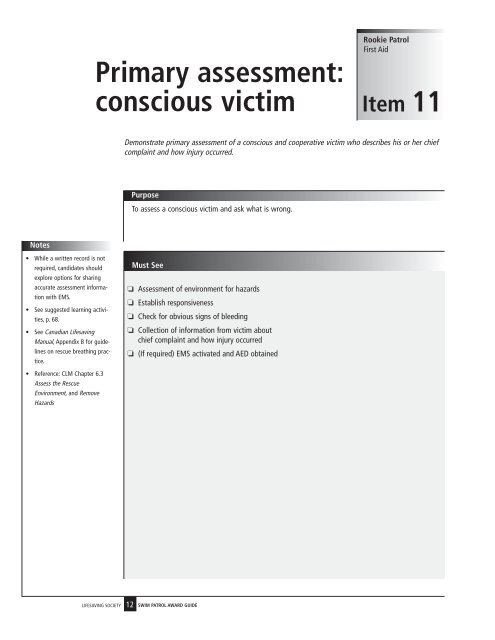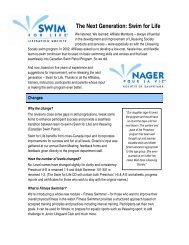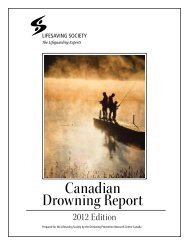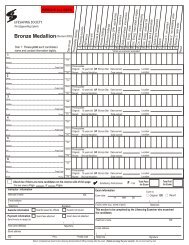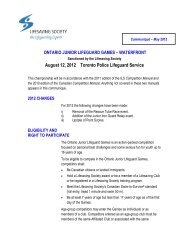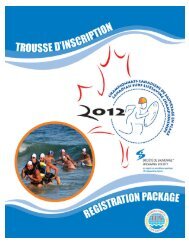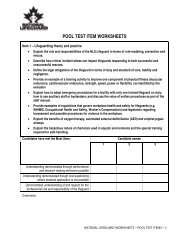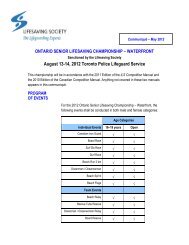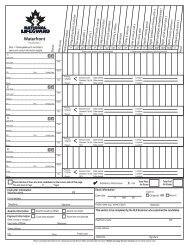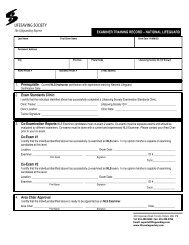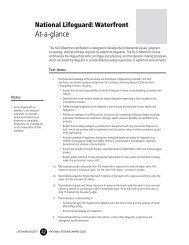Swim Patrol - Lifesaving Society
Swim Patrol - Lifesaving Society
Swim Patrol - Lifesaving Society
- No tags were found...
You also want an ePaper? Increase the reach of your titles
YUMPU automatically turns print PDFs into web optimized ePapers that Google loves.
Care for bleedingRookie <strong>Patrol</strong>First AidItem 13Demonstrate primary assessment and appropriate care for external bleeding.PurposeTo prevent further blood loss.Notes• Candidates should understandsome causes and dangers ofexternal bleeding.• Situations should be designedbased on simple, real-worldcontexts that candidates arelikely to encounter such asnosebleeds, scrapes and cuts.(Injury will not include embeddedobject.)• Candidates should develop andpractice simple strategies toavoid or minimize direct contactwith victim’s blood (e.g.,improvise using T-shirt, towel orother cloth).Must See❏ Assessment of environment for hazards❏ Establish responsiveness❏ Assess ABCs❏ Check for obvious signs of bleeding❏ Direct pressure❏ Rest and reassurance for victim❏ Recruit bystanders to assist rescuer❏ (If required) EMS activated and AED obtained• See suggested learning activities,p. 71.• Reference: CLM Chapter 8.5BleedingLIFESAVING SOCIETY14SWIM PATROL AWARD GUIDE
ShockRanger <strong>Patrol</strong>First AidItem 11Demonstrate emergency care for a victim in shock.PurposeTo treat and prevent further shock.Notes• Candidates should understandthe basic causes and dangers ofshock.• See suggested learning activities,p. 72.• Reference: CLM Chapter 6.4Conduct the PrimaryAssessment; 8.2 ShockMust See❏ Assessment of environment for hazards❏ Establish responsiveness❏ Assess ABCs❏ EMS activated and AED obtained (if available)❏ Maintenance of natural warmth❏ Rest and reassurance❏ Recovery position(unless injury dictates otherwise)❏ Bystanders recruited to assist rescuerLIFESAVING SOCIETY30SWIM PATROL AWARD GUIDE
Ranger <strong>Patrol</strong>First AidObstructed airway– conscious victim Item 12Simulate the appearance and treatment of a conscious adult or child victim with an obstructed airway.PurposeTo acquaint lifesavers with the appearance of a conscious adult or child victim with anobstructed airway and to introduce the appropriate lifesaving skills.Notes• Discuss common causes of airwayobstruction.• Supervise candidates carefullyduring training in obstructed airwaytechniques. Cautionrescuers to simulate treatment:misplaced or excessive thrustscan be dangerous.• Conscious victim simulateseither mild or severe airwayobstruction. To signal the type ofassistance needed, teach theuniversal choking signal.• Rescuer assumes severe obstructionif victim nods “yes” whenasked “Are you choking?” or ifvictim clutches neck or cannotspeak or breath.• Back blows, abdominal thrusts orchest thrusts are effective forrelieving severe airway obstructionin conscious adults and children.These techniques should beapplied in rapid sequence untilthe obstruction is relieved or thevictim becomes unconscious.More than one technique may beneeded; there is insufficient evidenceto determine which shouldbe used first.Some jurisdictions follow a standardizedprotocol. E.g., forEmergency or Standard First Aidin Quebec, abdominal thrusts orchest thrusts are used; while inOntario, 5 back blows alternatewith 5 abdominal thrusts. Followprovincial protocols.• See suggested learning activities,p. 71.• Reference: CLM Chapter 7.3Coping with Complicationsduring the ABCsMust See❏ Assessment of degree of obstruction – ask: “Are you choking?”❏ Selection of appropriate procedures:Mild obstruction❏ Coughing encouraged❏ Reassurance for victimSevere obstruction❏ Shout for help❏ Careful landmarking❏ Appropriate obstructed airway technique(s)❏ If successful, victim directed to see a physician to rule out complicationsfrom the obstruction or treatmentLIFESAVING SOCIETY31SWIM PATROL AWARD GUIDE
Star <strong>Patrol</strong>First AidRespiratoryemergencies Item 13Demonstrate the recognition and care of a victim suffering respiratory distress from:• asthma, or• severe allergic reactionPurposeTo demonstrate appropriate care for a respiratory emergency.Notes• Victim is conscious and cooperative.• Rescuer assists victim to findhis or her own prescribed medicationand prepare it foradministration. The victimadministers the medication;e.g., using asthma inhaler orinjecting epinephrine with theauto-injector.Rescuer should know how toassist with an auto-injector andhow to administer it if the victimis unable to do so.Must See❏ Assessment of environment for hazards❏ Establish responsiveness❏ Determination of cause (and removal if possible)of emergency❏ Victim placed in most comfortable position❏ Victim assisted to find and use medication(asthma inhaler or epinephrine auto-injector)❏ (If required) EMS activated and AED obtained• See suggested learning activities,p. 72.• Reference: CLM Chapter 8.3Airway and Breathing ProblemsLIFESAVING SOCIETY48SWIM PATROL AWARD GUIDE
NotesShockRecovery roll (Ranger 11)Review rolling a victim into a recovery position.Then partner candidates one behind the other.The first person lies down. The second personrolls the “victim” over and safely places him orher into recovery position. Continue until everyonehas turned the victim from various positions.Variations❏❏Try as a race, with penalties for unsafepractices.Each team starts with ten points. Dock apoint each time a roll is performed in anunsafe manner or recovery position is doneincorrectly. The winning team is the one withthe most points remaining at the end.Can’t blame it on a toad (Ranger 11)Introduce the acronym WARTS as a method forremembering how to treat shock:W for WarmthA for ABCs (Airway, Breathing, Circulation)R for Rest and reassuranceT for TreatmentS for Semi-prone (recovery) positionVariations❏❏❏❏Shout out, “W!” In response, candidatesshout, “WARMTH!” Repeat through all theletters. At the end shout, “Whatcha’ got?”Candidates respond, “WARTS!”Have a candidate lead the activity.Perform at times when it is unexpected. Forexample, at the finish of a fitness drill orrescue relay, or at the end of the class, initiatethe sequence by shouting “W.”Laminate or waterproof cards that eachfeature a letter in the word WARTS!Candidates tread water in the deep end.Give each a card. They organize themselvesinto lines to spell the word WARTS! On signal,they lift up their cards in order whileperforming eggbeater!Fractures & dislocationsBreaking news! (Star 12)Candidates choose a partner with a broken legor arm (simple closed injury of lower arms orlegs). Instruct victims to assume varying postures,e.g., lying down or simulating falling off achair or skateboard. Take candidates throughthe Must See requirements as a guide.Candidates watch and then imitate each step.Give verbal instruction as cues for the candidatesduring their demonstration. After onepartner has completed simulation of the completesequence, switch roles.Respiratory distressI needed that! (Star 13)Ask candidates if they know of anyone who isasthmatic or severely allergic and ask what typeof medication they carry and what it looks like.Candidates choose a partner. One person startsas the rescuer; the other simulates a consciousvictim (asthmatic or severe allergic reaction).Using props for an auto-injector or inhaler havepatrollers practice retrieving and preparing avictim’s medication for self administration. Note:Only use demos or props not real auto-injectorsor inhalers for learning activity. If candidate isunsure if the victim is asthmatic or suffering asevere allergic reaction, instruct rescuers to usethe auto-injector first.LIFESAVING SOCIETY72SWIM PATROL AWARD GUIDE


